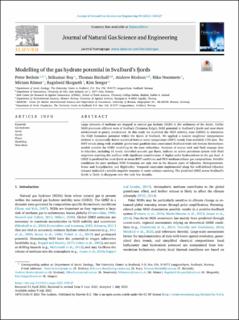| dc.contributor.author | Betlem, Peter | |
| dc.contributor.author | Roy, Srikumar | |
| dc.contributor.author | Birchall, Thomas | |
| dc.contributor.author | Hodson, Andrew | |
| dc.contributor.author | Noormets, Riko | |
| dc.contributor.author | Römer, Miriam | |
| dc.contributor.author | Skogseth, Ragnheid | |
| dc.contributor.author | Senger, Kim | |
| dc.date.accessioned | 2022-02-21T14:51:33Z | |
| dc.date.available | 2022-02-21T14:51:33Z | |
| dc.date.created | 2021-08-11T11:44:16Z | |
| dc.date.issued | 2021 | |
| dc.identifier.citation | Betlem, P., Roy, S., Birchall, T., Hodson, A., Noormets, R., Römer, M., . . . Senger, K. (2021). Modelling of the gas hydrate potential in Svalbard’s fjords. Journal of Natural Gas Science and Engineering, 94:104127. | en_US |
| dc.identifier.issn | 1875-5100 | |
| dc.identifier.uri | https://hdl.handle.net/11250/2980616 | |
| dc.description.abstract | Large amounts of methane are trapped as natural gas hydrate (NGH) in the sediments of the Arctic. Unlike NGH provinces offshore west of Svalbard (Vestnesa Ridge), NGH potential in Svalbard’s fjords and near-shore environment is poorly constrained. In this study we modelled the NGH stability zone (GHSZ) to determine the NGH formation potential within the fjords of Svalbard. We applied a nearest neighbour interpolation method to dynamically derive statistical bottom-water temperature (BWT) trends from available CTD data. The BWT trends along with available geothermal gradient data constrained Svalbard-wide sub-bottom thermobaric models suitable for GHSZ modelling in the near subsurface. Analyses of source rock and fluid seepage data in Isfjorden, including 15 newly identified acoustic gas flares, indicate an active petroleum system with fluid migration reaching the seafloor with significant contributions of higher-order hydrocarbons to the gas feed. A GHSZ is predicted for most fjords at mean BWT conditions and 95:5 methane:ethane gas compositions. Suitable conditions for pure methane NGH formation are only met in the deepest parts of Isfjorden, Hinlopenstretet, Kross- and Kongsfjorden, and Rijpfjorden. Temporal constraints implemented along the well-defined Isfjorden transect indicated a notable negative response to water column warming. The predicted GHSZ across Svalbard’s fjords is likely to disappear over the next few decades. | en_US |
| dc.language.iso | eng | en_US |
| dc.publisher | Elsevier | en_US |
| dc.rights | Navngivelse 4.0 Internasjonal | * |
| dc.rights.uri | http://creativecommons.org/licenses/by/4.0/deed.no | * |
| dc.title | Modelling of the gas hydrate potential in Svalbard's fjords | en_US |
| dc.type | Peer reviewed | en_US |
| dc.type | Journal article | en_US |
| dc.description.version | publishedVersion | en_US |
| dc.rights.holder | © 2021 The Authors. | en_US |
| dc.source.volume | 94 | en_US |
| dc.source.journal | Journal of Natural Gas Science and Engineering | en_US |
| dc.identifier.doi | 10.1016/j.jngse.2021.104127 | |
| dc.identifier.cristin | 1925287 | |
| dc.relation.project | Norges forskningsråd: 257579 | en_US |
| dc.relation.project | Norges forskningsråd: 228107 | en_US |
| dc.source.articlenumber | 104127 | en_US |
| cristin.ispublished | true | |
| cristin.fulltext | original | |
| cristin.qualitycode | 1 | |

